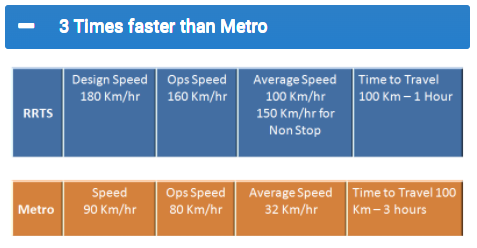Important Facts For Prelims
Regional Rapid Transit System (RRTS)
- 28 Jan 2022
- 3 min read
Why in News
Recently, the officials of Regional Rapid Transit System (RRTS) estimated that RRTS will reduce CO2 emissions by taking around 1.5 lakh private vehicles off the road.
- The corridor will start from Sarai Kale Khan in Delhi, pass through Ghaziabad, and reach Modipuram in Meerut (Uttar Pradesh).
- The RRTS, the first of its kind in the national capital, will run at a speed of 100 km per hour and commuters will reach Meerut in 50-60 minutes.
Key Points
- Background:
- The Planning Commission formed a Task Force in 2005 under the Chairmanship of Secretary, Ministry of Urban Development (MoUD) to develop a multi modal transit system for Delhi National Capital Region (NCR).
- This was included in the Integrated Transport Plan for NCR 2032 with special emphasis on Regional Rapid Transit System (RRTS) connecting regional centres.
- The Task Force identified 8 corridors and prioritised three corridors namely Delhi-Meerut, Delhi-Panipat and Delhi- Alwar for implementation.
- About RRTS:
- RRTS is a new, dedicated, high speed, high capacity, comfortable commuter service connecting regional nodes in NCR.
- RRTS is different from conventional Railway as it will provide reliable, high frequency, point to point regional travel at high speed along dedicated path way.
- RRTS is different from metro as it caters to passengers looking to travel a relatively longer distance with fewer stops and at higher speed.
- Intended Benefits:
- Environment Friendly: The corridor is estimated to reduce 2.5 lakh CO2 tonnes/year of total annual greenhouse gas emissions, making the city a cleaner and a much better place to live.
- Economic Development: It is estimated to increase the share of public transportation usage along the corridor from 37% to 63%.
- High-speed connectivity will result in balanced economic development across the region, leading to economic benefits to all strata of society and many nodes of development rather than all economic activity happening at one place.
- Sustainable Urbanization: The project will serve as a demonstration for developing high-capacity rapid urban transit corridors in other urban areas of India.
- It will help in reducing traffic congestion and total emissions from the transport sector in NCR.







